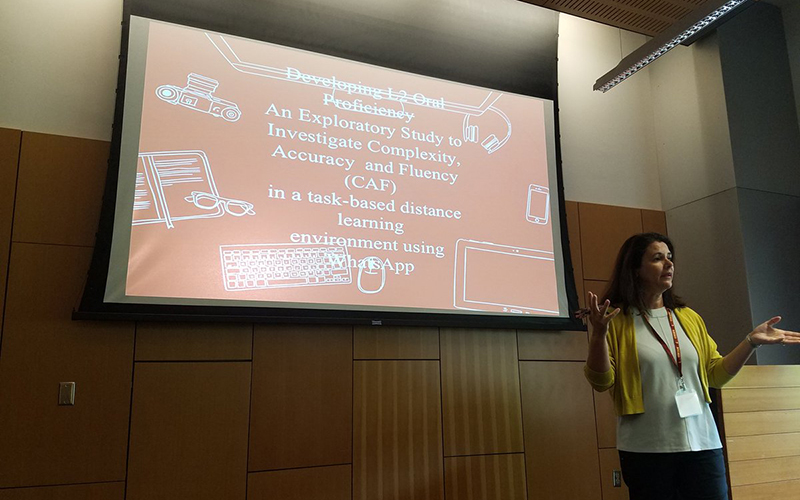
Professor Silvana Domaz, who teaches Spanish and Portuguese at Arizona State University, delivers a presentation about her use of WhatsApp with online students as a way to facilitate casual conversation. (Photo courtesy of AZCALL)
TEMPE — One takeaway from the Arizona Computer Assisted Language Learning conference was that mixing technology and languages, could soon make textbooks a thing of the past.
For the intermediate Spanish students in Silvana Domaz’ virtual classroom, some assignments have involved the use of WhatsApp, a free mobile application which lets users chat in real time.
The assignment consisted of students finding an event and having a conversation with another student about it through WhatsApp, instead of a discussion board on Blackboard, the web platform Arizona State University uses.
The feedback for the assignment was positive, according to Domaz, with students saying they found using the application was a more casual and conversational way to practice their language skills.
Domaz shared the inspiration for the use of the app in her classroom came from seeing another professor speaking about it.
Domaz, who teaches Spanish and Portuguese at ASU, presented her findings at the 2017 Arizona Computer Assisted Language Learning (AZCALL) conference which took place October 21 at the Tempe campus.
For the last four years, the conference has brought together foreign language professors from all over the state proposing and sharing innovative ways of using technology to improve student engagement.
Attendees either presented their findings or were interested in learning about ways to improve the way they teach students new languages.
Throughout the conference, Domaz was not the only who found the use of technology a supplementary tool which students are more rapidly embracing.
Maria Ocando, a doctoral student and Spanish professor at ASU who attended the conference, supplements her teaching by showing films in class.
“Film is a valuable option for students to learn about culture, and they can avoid the anxiety of traveling to a different country,” she said.
One problem to this approach is the way in which films are subtitled which is often by people who know very little about the culture being portrayed, Ocando said.
“Subtitles perpetuate stereotypes,” she said. “They present an incomplete version of reality and pass it off as complete.”
Her solution? Annotation.
While still in its early stages, Ocando suggested her colleagues consider using resources like the Berkeley Language Center’s library of foreign language film clips available only to instructors and professors teaching foreign languages.
The film library contains a collection of clips already pre-annotated to provide cultural, historical, and geographical context for the student watching the film clip. Ocando believes this can help override the sometimes culturally insensitive subtitles.
Another professor embracing the use of technology in the classroom is Timothy Ashe, who currently teaches intermediate Spanish at ASU.
Ashe mentioned he likes to use applications like Cahoot and Quizlet, web-based apps, to reinforce vocabulary lessons.
At the conference, Ashe’s presentation involved using NearPod, an interactive application which provides a platform for professors to create lessons. Students can follow along with the lesson on their phones, laptops or tablets.
While Ashe praises the use of technology in the classroom, he holds some reservations. One of his concerns is the possibility of technology in the classroom interfering with the actual learning.
“We have to find the balance between, is this worth adding the technology component or no, and is the technology component well planned or could the student actually learn the content better with less technology?” said Ashe.
While using applications and programs helps students engage and reinforce the language they are trying to learn, Ashe says knowing how to adapt and use innovative technology is a skill they’ll be able to apply outside of the classroom.
“Once they get into the real world and are working for businesses and organizations, a lot of those companies have their own app and they need to be able to know how to navigate through those spaces too,” said Ashe.